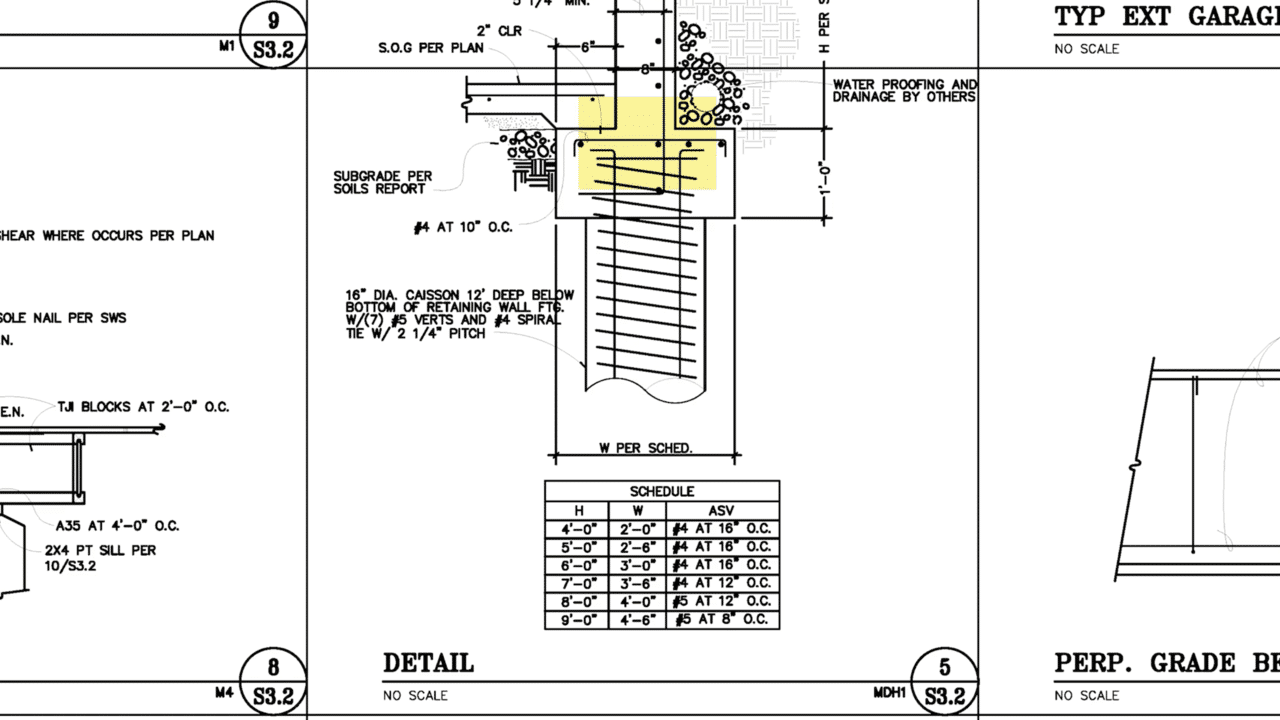What Is a Stem Wall Foundation and How Is It Different From a Monolithic Foundation?
Jun 30, 2020

Stem walls are the backbones of one of the five types of house foundations common in the United States, crawl space foundations. Here are the basics of how these short walls hold up large houses.
What is a stem wall?
A type of foundation common in much of the United States, stem walls are short (up to several feet, or the height of a crawl space) and are attached to a concrete footing. They are typically used in houses with crawl spaces, either vented or unvented, and are especially common in California, Texas, the Northwest, and the South. They are also a popular choice among architects designing homes in areas where earthquakes occur frequently.
Stem walls wouldn’t be used in houses with full basements, common in much of the Mid-Atlantic and Northeast as well as the Midwest, or those raised atop piers to sit above flood levels, as with those built in some coastal areas.
What are the advantages of stem wall foundations?
There are many reasons why crawl space foundations with stem walls are common. Here are a few of the most important:
- They’re solid. The stem walls transmit the load from the house to the footing (often a spread footing, which has a wider bottom section) and then it is distributed over a larger area.
- They protect the house itself. By lifting the base of the house, its walls are protected from flooding and some other environmental hazards.
- They allow easy access to plumbing, wiring, and other mechanical systems when compared to a slab foundation.
- The end result can be a more beautiful home. By raising the base of the house, the entire structure is elevated.
A special case: If the lot you are building on is on a slope, a stem wall foundation has some particular pluses in that its height can be varied depending on the ground elevation at different points. (In those situations, the amount of concrete required for a slab foundation can quickly become expensive.)
How are stem wall foundations constructed?
While there are variations on how stem walls are constructed, several first steps are common to all of them:
- Clear the site. Remove any plants as well as other debris. You’ll want to remove any large stumps, and also confirm with local authorities that no trees on the lot are protected.
- Compact the subgrade. Use a plate compactor and make additions to the soil (like gravel), if needed, to achieve a soil that is adequately dense and uniform for your project. You’ll only need large equipment like rollers for bigger projects.
- Pour the footings for the house. These concrete bases for the stem walls should be a minimum of 12 inches below the line of undisturbed soil and 12 inches below the frost line (or they should be frost protected). They should also be a minimum of 12 inches wide. The exact dimensions of footings will vary and will be determined in part by the type of soil at the site. If you are building on material with a high load bearing value (LBV), like bedrock, your footings may be smaller than at a site with sandy soil, which has a low LBV.
Stem walls made of concrete are sometimes referred to as “two pour foundations.” The first pour being for the footing and the second for the stem walls themselves.
During the construction of the stem walls above the footing, you’ll want to use vertical bars to assure that the walls do not slide off of the footing (a special concern in areas prone to earthquakes).
After you’ve constructed the stem wall, you can attach a sill plate (the structural base of the frame of the house) to the stem wall with anchor bolts (their number and size typically dictated by local building codes).
What are stem wall foundations made of?
Stem walls are most often built either of masonry (CMU or cinder blocks) or of concrete. Poured concrete walls have the advantage of a greater integral strength, which may be necessary in some areas with high winds as well as in flood zones. However, they involve greater effort and expense, as they require the construction of forms and bracing. Concrete stem walls may also require additional visits from inspectors.
Stem walls are the backbones of one of the five types of house foundations common in the United States, crawl space foundations. Here are the basics of how these short walls hold up large houses.
What is a stem wall?
A type of foundation common in much of the United States, stem walls are short (up to several feet, or the height of a crawl space) and are attached to a concrete footing. They are typically used in houses with crawl spaces, either vented or unvented, and are especially common in California, Texas, the Northwest, and the South. They are also a popular choice among architects designing homes in areas where earthquakes occur frequently.
Stem walls wouldn’t be used in houses with full basements, common in much of the Mid-Atlantic and Northeast as well as the Midwest, or those raised atop piers to sit above flood levels, as with those built in some coastal areas.
What are the advantages of stem wall foundations?
There are many reasons why crawl space foundations with stem walls are common. Here are a few of the most important:
- They’re solid. The stem walls transmit the load from the house to the footing (often a spread footing, which has a wider bottom section) and then it is distributed over a larger area.
- They protect the house itself. By lifting the base of the house, its walls are protected from flooding and some other environmental hazards.
- They allow easy access to plumbing, wiring, and other mechanical systems when compared to a slab foundation.
- The end result can be a more beautiful home. By raising the base of the house, the entire structure is elevated.
A special case: If the lot you are building on is on a slope, a stem wall foundation has some particular pluses in that its height can be varied depending on the ground elevation at different points. (In those situations, the amount of concrete required for a slab foundation can quickly become expensive.)
How are stem wall foundations constructed?
While there are variations on how stem walls are constructed, several first steps are common to all of them:
- Clear the site. Remove any plants as well as other debris. You’ll want to remove any large stumps, and also confirm with local authorities that no trees on the lot are protected.
- Compact the subgrade. Use a plate compactor and make additions to the soil (like gravel), if needed, to achieve a soil that is adequately dense and uniform for your project. You’ll only need large equipment like rollers for bigger projects.
- Pour the footings for the house. These concrete bases for the stem walls should be a minimum of 12 inches below the line of undisturbed soil and 12 inches below the frost line (or they should be frost protected). They should also be a minimum of 12 inches wide. The exact dimensions of footings will vary and will be determined in part by the type of soil at the site. If you are building on material with a high load bearing value (LBV), like bedrock, your footings may be smaller than at a site with sandy soil, which has a low LBV.
Stem walls made of concrete are sometimes referred to as “two pour foundations.” The first pour being for the footing and the second for the stem walls themselves.
During the construction of the stem walls above the footing, you’ll want to use vertical bars to assure that the walls do not slide off of the footing (a special concern in areas prone to earthquakes).
After you’ve constructed the stem wall, you can attach a sill plate (the structural base of the frame of the house) to the stem wall with anchor bolts (their number and size typically dictated by local building codes).
What are stem wall foundations made of?
Stem walls are most often built either of masonry (CMU or cinder blocks) or of concrete. Poured concrete walls have the advantage of a greater integral strength, which may be necessary in some areas with high winds as well as in flood zones. However, they involve greater effort and expense, as they require the construction of forms and bracing. Concrete stem walls may also require additional visits from inspectors.
Some consider stem walls of preservative-treated wood (also known as “pony walls”) to be a less expensive solution in some constructions—for example, on sites with good drainage and in remote locations where transporting concrete may be impossible. Vapor retarders and other treatments are necessary in order to protect the wood.
What’s the difference between stem wall and monolithic foundations?
A common alternative to stem walls, at least in some of the warmer parts of the United States, are monolithic foundations, sometimes called monoslabs. With monolithic concrete foundations, a single slab is poured with increased thickness along those sections that will support structural walls.
The main advantage of monolithic foundations is that they’re less expensive and quicker to construct, since the entire foundation is poured at once. Since buildings with monolithic foundations don’t have crawl spaces, there’s one less thing for the future homeowner to maintain.
Monolithic foundations are usually used in areas where the ground never freezes and are more common in tropical areas—in some countries, most houses are built using this method. In most of the United States, however, they are limited to outbuildings like garden sheds or garages. That said, there have been advances in the design of insulated slabs, also known as frost-protected shallow foundations (FPSF), increasing the possibilities for using them in areas where temperatures drop below freezing.
Even in warm climates, monolithic slabs may not be appropriate where the ground is insufficiently compacted. They can also have a tendency to crack at those sections under load bearing walls.
MT Copeland offers video-based online classes that give you a foundation in construction fundamentals with real-world applications. Classes include professionally produced videos taught by practicing craftspeople, and supplementary downloads like quizzes, blueprints, and other materials to help you master the skills.






